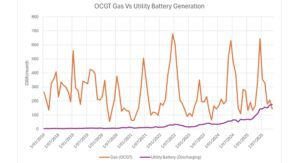The output records for renewable energy continue to fall around Australia’s main grid, with the latest round driven by a huge leap in rooftop solar that underlines the fundamental changes that are in full swing in the electricity system.
On Tuesday, as RenewEconomy reported, the output of wind and solar broke through the 20,000 megawatt (20 gigawatt) mark for the first time on the National Electricity Market (NEM), and set a new peak of 20,386 MW at 12.35pm (AEST).
On Wednesday, that record was broken again, with wind and solar output hitting a new peak of 20,984 MW at 12.50pm, but was what interesting about this new peak was the dominant role that rooftop solar was playing.
According to Geoff Eldridge, from data analysts GPE NEMLog, the output of rooftop solar mounted on the homes and businesses of energy consumers set a new peak of 13,058 MW at 12.30pm (AEST), a stunning leap from the previous record of 12,261 MW set in early October.
The growing influence of rooftop solar is significant. It is eating out the middle of the day lunch of the legacy coal generators, but also having an impact on utility scale solar and wind.
And because it means that it is the consumer rather than the legacy utilities producing this electricity, it is tipping the balance of power, quite literally, away from the incumbent generators.
And it shows no sign of slowing down. Rooftop solar set a new monthly installation record of 330 MW in November, according to SunWiz, and a good month in December may well break the yearly record of 3.2GW.
And with prices of solar modules at record lows, and tipped to fall another 50 per cent by 2040 according to some analysts, the uptake of rooftop solar will continue in future years, particularly with the growing push to electrify the home and transport.
One of the most notable trends identified by SunWiz is the growing size of rooftop solar systems, now averaging 9.9kW on homes, as consumers prepare for the switch to heat pumps (also at record levels), induction cooktops and electric vehicles, and because local networks are now allowing such systems to be installed.
Many analysts are calling on authorities, regulators and policy makers to embrace this change, and make sure the rules and protocols of the electricity systems are calibrated to take advantage of this asset, and to integrate them with battery storage and electric vehicles.
Among other renewable output records that fell on Wednesday, Queensland – the country’s most coal dependent state (in terms of generation share) posted a new record for wind and solar output of 6,845 MW, a rise of more than 2.2 per cent over its previous record of 6,699 MW.
South Australia’s large scale solar output also saw a significant rise, reaching 494.9 MW, an increase of 28.85 MW or 6.2 from the previous peak.
This reflects the recent addition of the second stage of the Tailem Bend solar farm, and increased demand from the current heatwave that prevented prices from going below zero, when most of the state’;s solar farms are obliged to switch off because of their contracts with off-takers.
(The wholesale prices in South Australia did go negative later in the afternoon as wind and solar provided more than 100 per cent of state demand, and large scale solar output briefly halved because of that).
GPE Nemlog also noted that rooftop PV output in Victoria also set a new record on Wednesday of 3,081.8 MW, up slightly from the record set a few days earlier. Expect more solar output records to fall in the coming week as the heatwave takes effect across the country.
The falling cost of solar – solar modules are already 42 per cent below their pre-Covid levels – and tipped to fall further because of the massive capacity built up in China, and because of improved efficiencies – contrasts with problems with wind, struggling with supply chain issues.
It presents an intriguing dilemma. Most models for grids dominated by wind and solar seek to have a balance between the two, because one blows mostly at night and the other shines through the day.
But if the solar ends up being as dirt cheap as many predict, might that provoke a change in the thinking about the those renewable grids are structured, with an increased focus on short term storage to soak up the excess solar – as Western Australia is encouraging already – and a different way of thinking about the value of wind?
It seems clear, now, that wind energy will never be able to match solar on costs. But it’s value as a diurnal offset is considerable – still significantly lower cost than fossil fuel alternatives to provide power through the night.
Consumers – big and small – are not going to stop installing rooftop PV, and regulators and policy makers shouldn’t try and stop them.
But they might have to start thinking creatively about the way they structure the incentive schemes, such as the Capacity Investment Scheme, that is designed to contract 23 GW of new wind and solar over the next four years, and provide the right incentive for offshore wind in the ensuing years.








